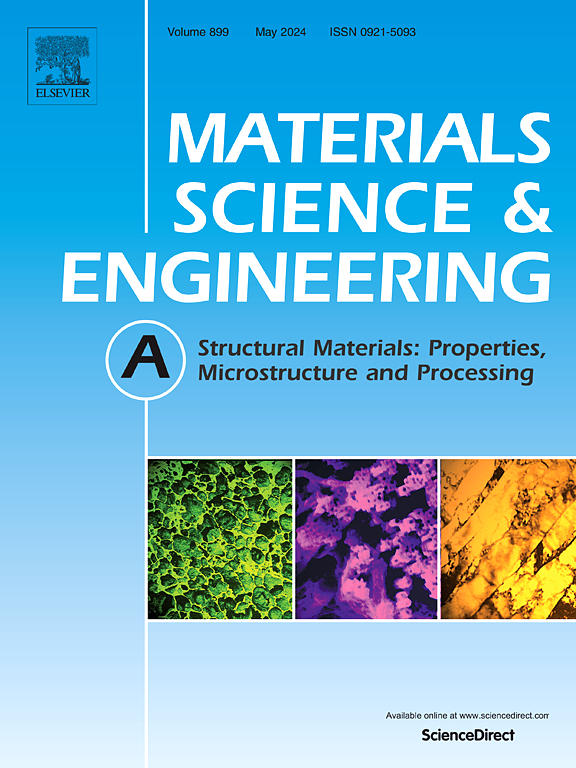晶间取向错误对纯镁变形机理和力学性能的影响
IF 6.1
2区 材料科学
Q1 MATERIALS SCIENCE, MULTIDISCIPLINARY
引用次数: 0
摘要
晶粒取向和晶间取向错误是影响镁(Mg)变形行为的两个关键因素。先前的大量研究已经证明,晶粒取向决定了作用在晶粒上的外载荷的分解剪应力的大小。然而,晶间取向错误对Mg变形机制和力学性能的影响尚不清楚。本文选择了晶粒尺寸相近但晶间取向错误分布明显的镁片和镁棒作为研究材料。对它们施加相同的加载路径,即垂直于大多数颗粒c轴的张力。然而,他们表现出相似的屈服强度,但不同的延展性。镁棒的伸长率几乎是镁片的三倍。统计滑移迹分析表明,棱柱滑移和锥体滑移在镁棒中表现出更高的活性。建立了不同滑移传递类型的几何相容系数(m′)与晶界取向偏差角(GBMA)之间的定量关系。结果表明(32°~ 72°)和(72°~ 90°)的GBMA分别有利于锥体滑移和棱柱滑移的激活。因此,GBMA在镁棒中的均匀分布是非基滑活性较高的关键因素,而GBMA在镁片(10°~ 32°)聚集不利于非基滑的启动。非基底滑移的高活动性导致镁棒的延展性显著提高。不同变形机制下相似的施密德因子(SF)值使镁棒的强度与镁片相当。因此,定制晶间错取向可以作为开发高强高塑性镁合金的一种新的设计理念。本文章由计算机程序翻译,如有差异,请以英文原文为准。
The influence of intergranular misorientation on the deformation mechanisms and mechanical properties of pure magnesium
Grain orientation and intergranular misorientation are two key factors affecting the deformation behavior of magnesium (Mg). Previous extensive studies have proven that grain orientation determines the magnitude of the resolved shear stress of external loading acting on grains. However, the influence of intergranular misorientation on the deformation mechanisms and mechanical properties of Mg is still unclear. In this work, the Mg-sheet and Mg-rod with similar grain size but distinct intergranular misorientation distribution were selected as the study materials. The identical loading path, tension perpendicular to the c-axis of most grains, was applied to them. However, they showed similar yield strength but distinct ductility. The elongation of the Mg-rod was almost three times that of the Mg-sheet. Statistical slip trace analysis indicated prismatic slip and pyramidal slip exhibited much higher activity in the Mg-rod. The quantitative relationship between the geometric compatibility factor (m’) for various slip transfer types and the grain boundary misorientation angle (GBMA) has been established. It indicated (32°∼72°) and (72°∼90°) GBMA were in favor of the activation of pyramidal slip and prismatic slip, respectively. Accordingly, the uniform distribution of GBMA in the Mg-rod is the key factor for the higher activity of non-basal slip while GBMA clustering at (10°∼32°) in the Mg-sheet is not conducive to the startup of non-basal slip. The higher activity of non-basal slip results in the significantly superior ductility of the Mg-rod. The similar Schmid factor (SF) values for various deformation mechanisms keep the strength of the Mg-rod comparable to the Mg-sheet. Accordingly, tailoring intergranular misorientation can serve as a novel design concept for developing high-strength and high-ductility Mg alloys.
求助全文
通过发布文献求助,成功后即可免费获取论文全文。
去求助
来源期刊

Materials Science and Engineering: A
工程技术-材料科学:综合
CiteScore
11.50
自引率
15.60%
发文量
1811
审稿时长
31 days
期刊介绍:
Materials Science and Engineering A provides an international medium for the publication of theoretical and experimental studies related to the load-bearing capacity of materials as influenced by their basic properties, processing history, microstructure and operating environment. Appropriate submissions to Materials Science and Engineering A should include scientific and/or engineering factors which affect the microstructure - strength relationships of materials and report the changes to mechanical behavior.
 求助内容:
求助内容: 应助结果提醒方式:
应助结果提醒方式:


